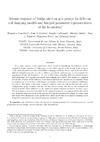Please use this identifier to cite or link to this item:
https://accedacris.ulpgc.es/jspui/handle/10553/43144
| Title: | Seismic response of bridge piers on pile groups for different soil damping models and lumped parameter representations of the foundation | Authors: | González, Francisco Padrón, Luis A. Carbonari, Sandro Morici, Michele Aznárez, Juan J. Dezi, Francesca Leoni, Graziano |
UNESCO Clasification: | 250618 Sedimentología 250705 Sismología y prospección sismica |
Keywords: | Biot's damping model Bridge seismic response Hysteretic dampipng model Pile foundations Soils-structure interaction |
Issue Date: | 2019 | Project: | Avances en El Desarrollo de Modelos Numéricos Para la Caracterización Dinámica de Cimentaciones Para Aerogeneradores Influencia de Los Fenómenos de Interacción Suelo-Estructura en la Respuesta Sísmica De |
Journal: | Earthquake Engineering and Structural Dynamics | Abstract: | This paper presents a wide parametric study aimed at elucidating the influence, on the computed seismic response of bridge piers, of two related aspects of the model: (1) the adoption of the classical hysteretic or the causal Biot's damping models for the soil and (2) the use of two different lumped parameter models of different complexity and accuracy to approximate the impedances of the pile foundation. A total of 2072 cases, including different superstructures, pile foundations, soil deposits, and seismic input signals, are studied. The results are presented so that the influence of the different parameters involved in the analysis can be assessed. From an engineering point of view, both lumped parameter models provide, in general, sufficiently low errors. The choice of the most adequate model for each case will depend not only on the configuration of the structure and the soil‐foundation system but also on the assumed soil damping model, whose influence on the computed seismic responses is relevant in many cases. The nonphysical behaviour provided by the classical hysteretic damping model for the soil at zero frequency generates issues in the process of fitting the impedance functions. It is also found that larger deck displacements are predicted by Biot's model due to the higher damping at low frequencies provided by the classical hysteretic damping model. | URI: | https://accedacris.ulpgc.es/handle/10553/43144 | ISSN: | 0098-8847 | DOI: | 10.1002/eqe.3137 | Source: | Earthquake Engineering and Structural Dynamics [ISSN 0098-8847], v. 48 (3), p. 306-327 |
| Appears in Collections: | Artículos |
SCOPUSTM
Citations
25
checked on Jun 8, 2025
WEB OF SCIENCETM
Citations
21
checked on Jun 8, 2025
Page view(s)
100
checked on Jan 14, 2024
Download(s)
293
checked on Jan 14, 2024
Google ScholarTM
Check
Altmetric
Share
Export metadata
Items in accedaCRIS are protected by copyright, with all rights reserved, unless otherwise indicated.
